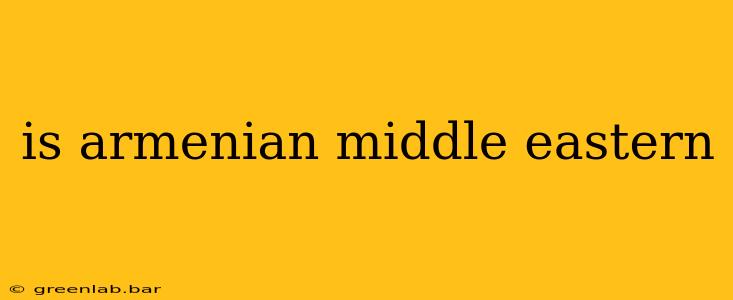Is Armenia Middle Eastern? A Complex Question of Geography and Culture
The question of whether Armenia is Middle Eastern is complex and doesn't have a simple yes or no answer. It depends heavily on how you define "Middle East," a term itself fraught with geopolitical and historical ambiguity. Let's explore the geographical, cultural, and historical factors that contribute to this nuanced discussion.
Geographic Location: A Borderland Perspective
Geographically, Armenia sits at the crossroads of Western Asia and Eastern Europe. It's located in the Caucasus region, a mountainous area bordered by Turkey, Georgia, Azerbaijan, Iran, and a sliver of Russia. While its proximity to Middle Eastern countries like Iran and Turkey might suggest a Middle Eastern affiliation, its location also places it firmly within the broader transcontinental region of Eurasia. This positioning makes assigning it solely to one geographical category problematic.
Cultural Influences: A Tapestry of Traditions
Armenia boasts a rich and unique culture shaped by centuries of interaction with various civilizations. Its history intertwined with those of the Middle East, particularly Persia (Iran), has undoubtedly left a significant cultural mark. However, Armenian culture also possesses distinct characteristics that differentiate it from purely Middle Eastern cultures. The Armenian language, its Apostolic Church, its traditional music, and its distinct culinary traditions all contribute to a separate and unique cultural identity. These are interwoven with influences from various regions, including Europe, showcasing its position as a bridge between continents rather than a solely Middle Eastern identity.
Historical Context: A Shifting Geopolitical Landscape
Historically, Armenia's relationship with the Middle East has been complex and often turbulent. It has been part of various empires, including Persian, Ottoman, and Russian, each leaving its imprint on the country's identity. However, it's crucial to remember that Armenia has also maintained its own distinct national identity throughout these periods of foreign rule, resisting complete assimilation. The Armenian Genocide, a devastating event in the early 20th century perpetrated by the Ottoman Empire, further underscores the nation's unique historical trajectory and challenges the idea of simply categorizing it as part of the Middle East.
Defining "Middle East": A Matter of Perspective
The term "Middle East" itself lacks a universally agreed-upon definition. Its boundaries are fluid and often influenced by political and cultural biases. Some definitions emphasize geographical proximity to the Middle East, while others focus on cultural or religious similarities. Depending on the chosen definition, Armenia's inclusion or exclusion from the Middle East becomes a matter of interpretation.
Conclusion: A Transcontinental Identity
In conclusion, labeling Armenia as simply "Middle Eastern" is an oversimplification. Its geographical location, cultural tapestry, and historical experiences contribute to a unique and multifaceted identity. It's more accurate to consider Armenia a transcontinental nation, situated at the crossroads of Western Asia and Eastern Europe, with cultural and historical connections to both regions, but possessing its own distinct and independent identity. The question isn't about definitively placing Armenia in one box or another, but about appreciating the richness and complexity of its position in the world.

